
The Right Ramp Can Make Your Life Easier
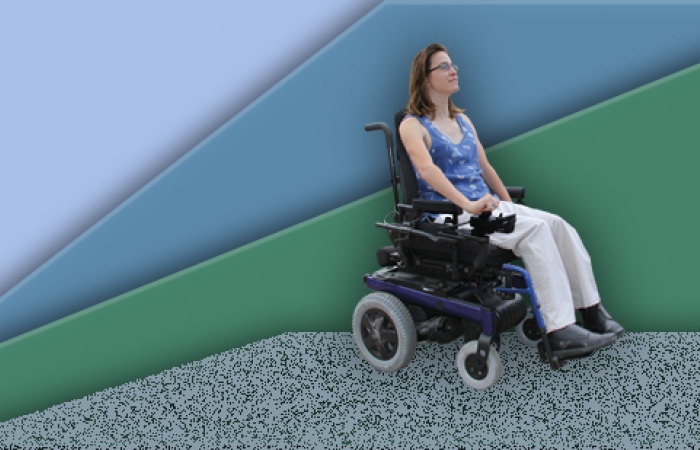
Getting on the level
Whether facing a 2-inch-high curb or a 3-foot-tall porch, the results for a person in a wheelchair can be exactly the same: no passage.
The way around both these barriers is, of course, a wheelchair ramp, though they will be decidedly different. The first might be a portable, foldable aluminum device, while the second might be a large, permanent structure made of concrete or galvanized steel.
This article provides a look at a variety of ramps available to help you surmount barriers big and small.
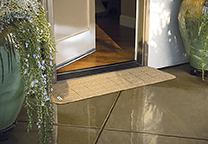 Follow ADA guidelines
Follow ADA guidelines
The Americans with Disabilities Act (ADA) has myriad accessibility guidelines and ramp specifications — far more than we can include here. See the resource list for several excellent websites containing this information, plus tips and techniques for building ramps.
Buying from a disability ramp manufacturer should ensure your ramp meets ADA standards. If you decide to have a custom ramp built, be sure to search for a "disability ramp contractor" who is experienced working with ADA ramp requirements and understands the particular needs of wheelchair users.
Threshold ramps for around the house
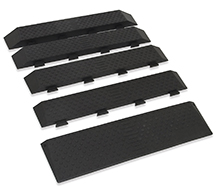 Let’s start with the small barriers first, such as the doorway into a house. A person walking through a doorway most likely won’t notice an inch-and-a-half height variation, but someone in a wheelchair most certainly will.
Let’s start with the small barriers first, such as the doorway into a house. A person walking through a doorway most likely won’t notice an inch-and-a-half height variation, but someone in a wheelchair most certainly will.
This is where a very simple transition product called a threshold ramp can be installed easily.
Threshold ramps generally are made of heavy-duty rubber or aluminum. First, measure the height difference of the two levels to be spanned. If it’s in the 1-to-2½-inch range, a rubber threshold ramp is the easiest solution.
Simply buy the height you need and butt it up under the doorsill much like a welcome mat. They’re heavy and slip-resistant enough to stay in place on their own.
Segmented designs allow you to combine ramp sections to reach greater heights — up to 3 or 4 inches. (Some of these rubber products are made from recycled tires.)
Threshold ramps also come in heavy-duty aluminum. One type is wedge-shaped and self-supporting, similar to the rubber models. Another wedge-shaped model comes with adjustable feet to increase the height.
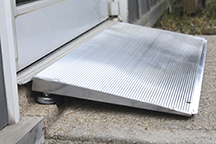 Still another type is basically a flat sheet of aluminum, beveled at top and bottom and covered with a high-traction surface. These designs cover a range of heights from less than 1 inch up to 4 inches.
Still another type is basically a flat sheet of aluminum, beveled at top and bottom and covered with a high-traction surface. These designs cover a range of heights from less than 1 inch up to 4 inches.
If the height differential is 5 or 6 inches, consider an interlocking aluminum-segment design that allows the height to be adjusted from 1 inch up to 6 inches.
Of course, the higher the ramp, the longer it will be. A 6-inch ramp of this type will be about 2½ feet in length.
Portable ramps: Put ’em where you need ‘em
The most basic portable ramp is a one-piece solid aluminum ramp with safety side rails (sometimes called curbs) that looks something like an open-ended tray.
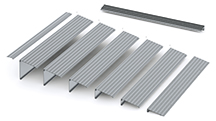 These ramps generally range in width from 30 to 36 inches and in length from 2 to 10 feet. Although these solid designs are considered portable, the longer lengths usually are placed permanently around the home, often outside.
These ramps generally range in width from 30 to 36 inches and in length from 2 to 10 feet. Although these solid designs are considered portable, the longer lengths usually are placed permanently around the home, often outside.
To make them more portable, some models have hinges and an attached handle, allowing them to fold into smaller, easier-to-transport packages. With a single-fold design, the ramp (from 2 to 6 feet in length) is hinged down the middle, creating a package half as wide.
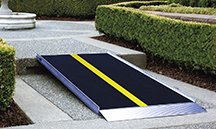 Many wheelchair users store one of these foldables in their vans in case they meet up with an unexpected barrier when they’re out and about. (An ambulatory partner usually needs to help with folding/unfolding and ramp placement.)
Many wheelchair users store one of these foldables in their vans in case they meet up with an unexpected barrier when they’re out and about. (An ambulatory partner usually needs to help with folding/unfolding and ramp placement.)
Multifold ramps are hinged both lengthwise and widthwise to further reduce their size for transporting. Some models even split into two lighter-weight folded pieces.
Speaking of lighter weight, foldable ramps made of fiberglass are said to be as sturdy as aluminum.
Modular options for bigger barriers
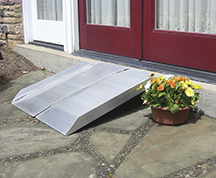 Up to this point, we’ve solved the problem of pesky thresholds, assorted bumps and curbs, even a step or two up to a low deck. But what about something higher, say, three or four steps up to a porch?
Up to this point, we’ve solved the problem of pesky thresholds, assorted bumps and curbs, even a step or two up to a low deck. But what about something higher, say, three or four steps up to a porch?
One solution is a modular ramp — essentially a giant kit with basic components (such as ramp sections, turning platforms and handrails) that can be configured to just about any porch-approach situation.
Whether you need only a single-section ramp running straight up to the porch or a multiple-section ramp with several landings and a 45-degree-angle turn to avoid that beloved shade tree in the front yard, there are modules to accommodate your particular needs.
To design a modular ramp, contact a manufacturer to find the dealer or franchise in your area (see resource list). The dealer then will send a representative to study the layout of your yard in relation to your porch, design a ramp and provide an estimate. This service usually is free, but be sure to ask when you call.
Once you’ve found the ramp and price that suits you, the dealer will send out the components and a crew to build it; depending on the complexity of the job, it usually will be up in a matter of hours. (Modular ramps generally do not require building permits.)
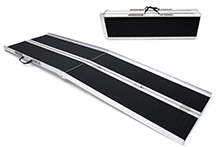 You say there’s a talented do-it-yourselfer in the family? Some, but not all, of these ramp companies say their ramps, with major components pre-assembled, can be constructed by able and willing handymen with no need for specialized tools. Be sure to ask about this when talking to the estimator; it could save you some money.
You say there’s a talented do-it-yourselfer in the family? Some, but not all, of these ramp companies say their ramps, with major components pre-assembled, can be constructed by able and willing handymen with no need for specialized tools. Be sure to ask about this when talking to the estimator; it could save you some money.
Most modular companies offer aluminum ramps. The big advantage of aluminum is that once the ramp is built, there’s virtually no maintenance: no rust to arrest, no aging wood to protect every winter.
However, for some people, an aluminum ramp in the front yard doesn’t exactly blend into its immediate environment. If this is a concern, two of the companies featured here offer black steel ramps, while another offers ramps that combine treated wood railings with an aluminum framework.
These ramps have a more subtle appearance compared to the shiny all-aluminum models. However, aluminum can be "painted" electrostatically in any color, so another option is to ask the manufacturer if they offer powder coating finishes for their ramps.
Other options, other ramps
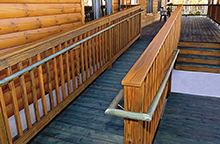 For a ramp that looks like it’s part of the original design of the home, you’ll probably need a local builder to design and construct it, using wood or other materials that match your residence.
For a ramp that looks like it’s part of the original design of the home, you’ll probably need a local builder to design and construct it, using wood or other materials that match your residence.
If you select wood as the main ramp material, just remember that to keep it safe and looking good, it needs to be maintained on a regular basis.
One option: If you have an attached garage with a door leading directly into the house, you might be able to build a custom wood ramp inside the garage, greatly reducing ramp maintenance (both labor and costs). The downside is that your two-car garage may no longer fit two cars.
Without a doubt, the sturdiest ramp on the planet with the least amount of maintenance is made of concrete. It’s also the most permanent, so if this is the type of ramp you want, you’d better get it right the first time.
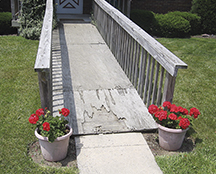 This is not a job for the average do-it-yourselfer. Be sure to contact a reputable concrete contractor who is well-versed in ADA compliancy.
This is not a job for the average do-it-yourselfer. Be sure to contact a reputable concrete contractor who is well-versed in ADA compliancy.
One is good, two is better
Once you have your primary entry ramp figured out, give some thought to a secondary ramp that can be used as an emergency exit. It doesn’t have to be fancy; it just needs to be sturdy and ready to use in case a fire or other emergency cuts off access to the main ramp.
Perhaps it’s nothing more than a portable ramp over the back steps; just make sure it’s always in place.
Buying a ramp
By visiting manufacturer websites (or calling their toll-free number), you should be able to find a ramp dealer in your area. To view portable ramps in person, check with local durable medical equipment dealers or a firm that sells wheelchairs. Smaller ramps may be available at large building supply stores such as Lowe’s.
Before you start ramp shopping (in person or online) determine the approximate total weight of you and your chair, and the width of your chair. Many power chairs are in the 150- to 250-pound range, but some of the newer, fully loaded models with standing capabilities can weigh as much as 350 pounds. Some smaller ramps have a load capacity of 600 pounds, while most of the larger modular ramps will hold 800 pounds or more. Be sure that custom-built or general-purpose ramps can carry the load.
What’s it going to cost?
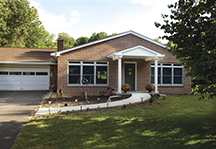 When shopping for a wheelchair ramp, brace yourself for sticker shock. They’re not cheap.
When shopping for a wheelchair ramp, brace yourself for sticker shock. They’re not cheap.
Yes, with some of the smaller barrier heights, a sturdy piece of plywood just might do the trick … for a while. If it’s protected from the weather, it might even last a long time, although it may look a bit homely. As you might expect, ramps are pricey because they’re constructed of heavy-duty materials designed to support a minimum of 600 pounds or more.
Prices vary, but here are some ballpark estimates. Aluminum threshold ramps can range from $65 to around $150, depending on the rise. Rubber threshold ramps tend to range from $65 to more than $300. Solid, aluminum ramps in the 3- to 5-foot range can cost from $150 to $400. Single-fold 4-foot “suitcase” ramps range in price from $150-$260. Multifold 6-foot ramps range from $200-$400.
In the larger modular ramp systems, the complexity and length of the design (how many ramp sections, landings or platforms, handrails and accessories) and the materials they’re made of will dictate the price.
For example, a typical modular aluminum porch ramp might be 36 inches wide, with handrails, and include, say, an 8-foot ramp section that travels up to a 5-foot-square landing, where it makes a 90-degree right turn and connects to a 6-foot ramp leading to the porch. These three sections could cost in the neighborhood of $3,500. Shipping and local installation might add another $400 to $500 to the total. This same design in steel might cost around $3,000 installed; constructed locally with wood, it could cost around $2,000.
Obviously, these are very general prices; there are myriad options and factors that could vary the final tally in your particular location. The only way to get an accurate quote for your particular situation is to contact a manufacturer who will get you in touch with a representative in your area.
Ramps, then, can be an expensive proposition, but it’s money wisely spent. Consider it an investment in making your life easier, safer and more independent.
Modular configurations
Three of many turning configurations possible for an aluminum modular wheelchair ramp. (Illustrations courtesy of PVI)
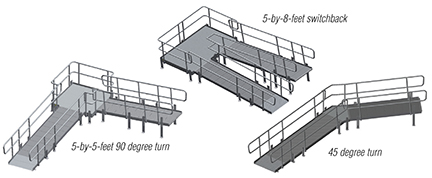
MDA Resource Center: We’re Here For You
Our trained specialists are here to provide one-on-one support for every part of your journey. Send a message below or call us at 1-833-ASK-MDA1 (1-833-275-6321). If you live outside the U.S., we may be able to connect you to muscular dystrophy groups in your area, but MDA programs are only available in the U.S.
Request Information